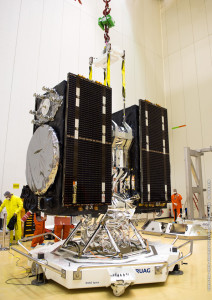Galileo Launch 6. Arianespace Soyuz flight VS13 launched Galileo FOC-M4, satellites 11 and 12 from Guiana Space Center in Kourou, French Guiana, on 17 December 2015.
Monthly Archives: December 2015
Soyuz VS13 mission
This is a summary of the main milestones achieved in Kourou in the last days, before declaring the green light in the Launch Readiness Review.
December 10
Installation of Galileo 11 and 12 and their dispenser system atop Soyuz Fregat occurred in the European Spaceport’s S3B clean room facility. The dispenser will deploy the satellites by firing a pyrotechnic system for separation in opposite directions at the orbital insertion point.
Fregat operates as Soyuz’ fourth stage, providing an autonomous and flexible propulsion system. Built by Russia’s NPO Lavochkin, it will perform two propulsion burns during the Galileo mission with the upper stage designed to be restarted up to 20 times in flight.
December 14
Rollout and vertical positioning of the Soyuz three-stage vehicle. Soyuz was moved via a transport/erector rail car in a horizontal-transfer process from the MIK launcher assembly facility to the Soyuz ELS launch complex. Once on the launch pad, Soyuz was erected to the vertical orientation, where it was suspended in place by four large support arms, followed by the transport/erector rail car’s withdrawal. Read more…
[VID] VS13 Launch campaign
The two Galileo spacecraft for Arianespace’s latest Soyuz launch at the service of Europe’s Galileo satellite-based navigation system, and the company’s record 12th mission overall in 2015, have been integrated at the Spaceport in preparation for their December 17 liftoff from French Guiana.
Giuliano Gatti, ESA’s Galileo Space Segment Manager.
Thierry Fahem, Arianespace Galileo sat 11-12 project director.
Thierry Wilmart, Arianespace Galileo sat 11-12 mission director
Jean-Claude Garreau, Arianespace Launch Site Operations Manager
Press briefing on Galileo Launch 6
The next two satellites in Europe’s Galileo satellite navigation system will be launched together on 17 December, concluding a year that will double the number of Galileo satellites in orbit. Media are invited to take part in an audio briefing on 16 December.
Galileo satellites 11/12 are scheduled to lift off at 11:51 GMT on 17 December (12:51 CET; 08:51 Kourou time) from Europe’s Spaceport in French Guiana on a Soyuz rocket. They are expected to become operational, after initial in-orbit testing, next spring.
This is the sixth Galileo launch overall and the third this year, set to bring the number of satellites in space up to 12.
This launch takes place just 10 days before the 10th anniversary of the liftoff of Europe’s very first navigation satellite. Since the experimental GIOVE-A took off on 27 December 2005, not only has the first third of the Galileo constellation reached orbit, but a network of Galileo ground stations has been built across the globe. Read more…
[VID] Galileo is real
On 17 December, Galileo satellites 11 and 12 will be launched on top of the legendary Soyuz rocket from Europe’s Spaceport in French Guiana. Ten years after the launch of GIOVE A, on 28 December 2005, Galileo is now a reality.
Galileos 7 & 8 broadcasting navigation signals
Having completed their rigorous checks in space, two more of Europe’s Galileo satellites are now fully operational, broadcasting navigation signals and, from today, relaying search and rescue messages from across the globe.
Galileos 7 and 8 were launched from Europe’s Spaceport in French Guiana on 27 March. Once the satellites were nursed to life in orbit, their navigation payloads underwent a lengthy test campaign.
This involved assessing that the satellites themselves were performing as planned and meshing with the worldwide Galileo ground network.
The satellites’ secondary search and rescue payloads were also put to the test, picking up and relaying UHF signals from distress beacons as part of the international Cospas–Sarsat system. Read more…


